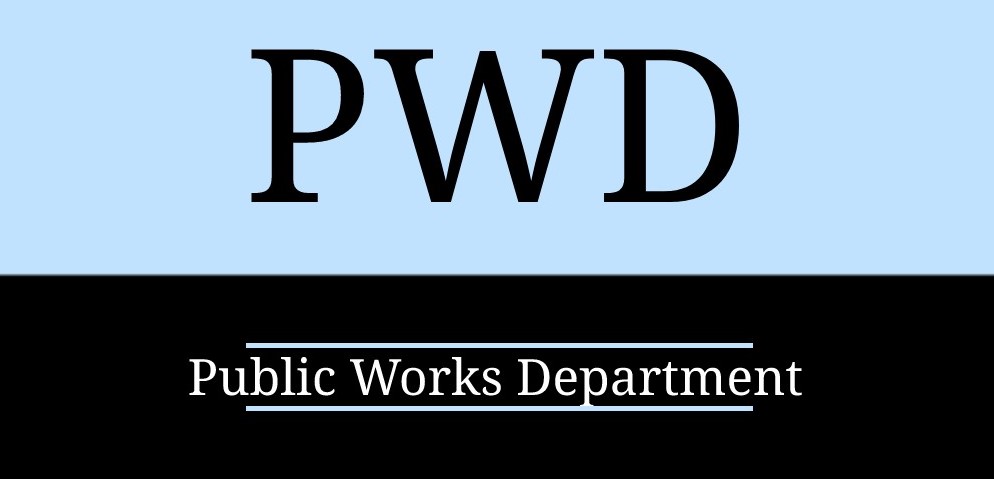PWD full form is Public Works Department, PWD is a government agency that is responsible for the planning, construction, and maintenance of public infrastructure. This includes roads, bridges, buildings, irrigation systems, and other essential infrastructure.
- PWD full form: Introduction
- PWD full form: Role and Responsibilities
- PWD full form: Organizational Structure
- PWD full form: Functions and Services
- PWD full form: Importance of PWD
- PWD full form: Challenges and Constraints
- PWD full form: Future Trends and Innovations
- PWD full form: Conclusion
- PWD full form: FAQs
PWD full form: Introduction

The Public Works Department (PWD) is a vital governmental institution responsible for the planning, design, construction, and maintenance of essential public infrastructure. This includes an array of projects that aim to enhance the quality of life for citizens, ensuring the smooth functioning of communities and economies.
The scope of PWD’s responsibilities covers a broad spectrum, including the construction and maintenance of roads, bridges, flyovers, government buildings, water supply systems, and sewerage networks. Essentially, it’s about creating and sustaining the foundational structures and facilities that are crucial for societal progress and development.
Purpose and Importance
The primary purpose of the Public Works Department is to facilitate the development and maintenance of key infrastructure essential for a nation’s growth. Well-maintained roads and highways, sturdy bridges, efficient water supply systems, and functional public buildings are the backbone of any progressive society. These elements play a pivotal role in fostering economic growth, ensuring public safety, and enhancing the overall quality of life.
Historical Background
The concept of a Public Works Department traces back to the early civilizations, where there was a recognized need for organized efforts to construct and maintain public infrastructure. Over centuries, the role and responsibilities of public works have evolved in response to the changing needs and demands of growing societies.
Today, the PWD operates as a well-structured governmental department with specialized divisions focusing on various aspects of public infrastructure. Modern PWDs employ advanced engineering techniques, adhere to stringent safety and quality standards, and integrate innovative technologies to deliver projects that meet the dynamic requirements of contemporary societies.
PWD full form: Features and Benefits of Recurring Deposits
| Aspect | Description |
|---|---|
| 1. Infrastructure Development and Maintenance | The PWD is at the forefront of planning, designing, constructing, and maintaining essential public infrastructure. This includes roads, highways, bridges, dams, airports, government buildings, and other structures vital for transportation, communication, and public services. |
| 2. Planning and Execution of Public Projects | PWD is responsible for comprehensive project planning, from initial conceptualization to detailed execution plans. This involves feasibility studies, budget estimations, scheduling, resource allocation, and ensuring projects align with safety and environmental regulations. |
| 3. Regulatory Compliance and Standards | PWD ensures strict adherence to governmental regulations and safety standards in all its projects. Compliance with building codes, environmental norms, and occupational health and safety guidelines is paramount to ensure the well-being of workers and the sustainability of the projects. |
| 4. Traffic Management and Road Safety | One of the core responsibilities is to manage traffic flow efficiently and enhance road safety. This involves implementing traffic rules, road signage, speed limits, and developing strategies to minimize congestion and accidents. |
| 5. Disaster Preparedness and Management | PWD plays a crucial role in disaster preparedness by reinforcing critical infrastructure to withstand natural calamities. Additionally, they are involved in disaster management, ensuring quick restoration and recovery of public services after disasters. |
| 6. Urban and Rural Development | From constructing urban landmarks to improving rural connectivity, PWD aims to bridge the urban-rural divide. This includes the development of rural roads, irrigation systems, and other facilities to enhance the overall living standards in rural areas. |
| 7. Water Supply and Sanitation | PWD oversees the planning, development, and maintenance of water supply systems, reservoirs, water treatment plants, and sewerage networks to ensure access to clean water and proper sanitation facilities for communities. |
| 8. Budgeting and Financial Management | Responsible for budget allocation and financial management of all infrastructure projects, PWD ensures optimal utilization of funds to complete projects on time and within budget constraints. |
PWD full form: Organizational Structure
The organizational structure of the Public Works Department (PWD) is designed to efficiently manage and execute the various responsibilities and tasks associated with infrastructure development and maintenance. It is typically organized hierarchically with several levels of management and specialized divisions.
1. Head of the Department
At the top of the hierarchy is the Head of the Department, often referred to as the Chief Engineer or Director General. This individual holds the highest authority and is responsible for overseeing the entire department’s functioning.
2. Senior Management
Under the Head of the Department, there are senior management positions, including:
- Deputy Chief Engineers: Responsible for specific branches or regional divisions and report directly to the Head of the Department.
3. Functional Divisions or Branches
The PWD typically comprises several functional divisions or branches, each specializing in a specific aspect of public works. These may include:
- Roads and Highways Division: Responsible for the planning, construction, and maintenance of roads and highways.
- Buildings Division: Focuses on the construction and maintenance of public buildings, government offices, and residential complexes.
- Electrical and Mechanical Division: Oversees electrical and mechanical aspects of projects, including power supply, installations, and maintenance.
4. Regional and Circle Offices
These are geographical subdivisions, often based on states, regions, or zones, each headed by a Superintending Engineer. Regional offices manage projects and activities within their respective areas.
5. Project Management Units (PMUs)
PMUs are units dedicated to specific projects. They handle planning, execution, and monitoring of projects, ensuring they meet specified standards and are completed within set timelines.
6. Field Staff
At the grassroots level, field staff includes:
Executive Engineers: In charge of project execution, implementation, and management within their jurisdiction.
- Assistant Engineers and Junior Engineers: Assist in project management and implementation under the supervision of Executive Engineers.
7. Support Staff
This category includes administrative staff, accountants, clerks, and other supporting roles that assist in day-to-day functioning and documentation within the department.
PWD full form: Functions and Services
| Function/Services | Description |
|---|---|
| 1. Road Construction and Maintenance | Construction, repair, and maintenance of road networks. This includes planning, designing, building new roads, and resurfacing existing ones, all while ensuring adherence to safety and quality standards. |
| 2. Bridge and Structure Construction | Construction of bridges, flyovers, and crucial transportation structures. PWD ensures the structural integrity of these constructions, allowing safe passage for commuters and cargo. |
| 3. Building Construction and Maintenance | Construction and maintenance of various structures, including government buildings, public facilities, offices, hospitals, schools, and recreational spaces. These projects contribute to the overall well-being and convenience of the community. |
| 4. Water Supply and Sewerage Management | Provision and management of a steady and clean water supply to communities. Additionally, PWD oversees the management of sewerage systems, treating and disposing of wastewater to maintain a hygienic environment and ensure public health. |
| 5. Disaster Preparedness and Relief Works | Reinforcement of critical infrastructure to withstand natural disasters and coordination of disaster management efforts. PWD plays a pivotal role in ensuring quick restoration and recovery of public services in the aftermath of disasters. |
| 6. Urban and Rural Development | Development initiatives in both urban and rural areas. In urban regions, this involves landmark construction, transportation network development, and utility improvements. In rural areas, PWD focuses on enhancing connectivity, irrigation systems, and essential facilities to elevate the quality of life. |
| 7. Traffic Management and Road Safety | Implementation of traffic management measures to ensure smooth flow and minimize accidents. PWD enforces traffic rules, installs road signage, sets speed limits, and develops strategies to enhance road safety and reduce congestion on the roads. |
| 8. Public Infrastructure Planning | Comprehensive planning for various public projects. This includes conducting feasibility studies, estimating costs, and allocating resources to ensure efficient execution of projects within specified budgets and timelines. |
PWD full form: Importance of PWD
The Public Works Department (PWD) holds immense significance due to its crucial role in enhancing the infrastructure and overall development of a region, impacting the lives of its inhabitants in numerous ways.
1. Infrastructure Backbone
PWD forms the backbone of a nation’s infrastructure. Roads, bridges, buildings, and water supply systems are essential components that facilitate trade, transportation, communication, and daily activities. PWD’s construction and maintenance ensure a smooth and functional infrastructure network.
2. Economic Growth
A well-developed infrastructure is vital for economic growth. Efficient transportation systems provided by PWD support the movement of goods and people, bolstering commerce and trade. Improved infrastructure attracts investments, spurs entrepreneurship, and fosters economic prosperity.
3. Public Safety and Health
Road safety and proper sanitation are vital for public health and safety. PWD’s management of traffic, road signage, and sewerage systems significantly contribute to maintaining a healthy and safe environment for communities.
4. Disaster Preparedness
In regions prone to natural disasters, PWD’s role is paramount. Reinforcing critical infrastructure to withstand calamities and swiftly restoring services post-disaster ensures the safety and well-being of the population during challenging times.
5. Urban and Rural Development Balance
PWD plays a vital role in bridging the gap between urban and rural areas. By developing urban landmarks and improving rural connectivity, it ensures equitable development, enhancing the overall quality of life for both urban and rural dwellers.
6. Community Well-Being
By constructing and maintaining public buildings like schools, hospitals, and recreational facilities, PWD directly contributes to the well-being of communities. Accessible and well-maintained public infrastructure positively impacts education, healthcare, and leisure activities.
PWD full form: Challenges and Constraints
| Challenge | Description |
|---|---|
| 1. Funding and Budget Constraints | Insufficient funds allocated for extensive projects often lead to delays or compromises in quality. Budget constraints can hinder the timely completion and optimal execution of crucial infrastructure initiatives. |
| 2. Technological Advancements and Adaptation | The fast-paced evolution of technology requires PWD to continually adapt. Incorporating new technologies efficiently and training personnel to use them effectively can pose a challenge, especially in regions where access to advanced technology and expertise is limited. |
| 3. Environmental and Social Impact Concerns | Balancing development with environmental sustainability and addressing social concerns is critical. PWD faces challenges in minimizing the adverse environmental and social impacts of projects while meeting the infrastructure needs of growing populations and urbanization. |
| 4. Skilled Workforce Shortages | The demand for a skilled workforce often exceeds the availability. Recruiting and retaining qualified personnel, especially in specialized areas such as advanced engineering and sustainable practices, can be challenging due to competition and a limited pool of skilled professionals. |
| 5. Political and Regulatory Dynamics | Changing political landscapes and evolving regulations can influence project timelines and funding availability. The uncertainty and impact of political decisions on infrastructure projects, combined with varying regulations, can pose challenges in project planning and execution. |
| 6. Public Acceptance and Opposition | Public opposition, concerns, or resistance to projects due to various reasons like environmental impact, displacement, or other socio-economic factors can stall or delay projects. Garnering public support, addressing concerns, and ensuring community engagement is essential to move projects forward smoothly. |
PWD full form: Future Trends and Innovations
1. Smart Infrastructure Initiatives
The integration of technology into infrastructure is a growing trend. “Smart infrastructure” incorporates sensors and real-time monitoring, enabling predictive maintenance and efficient resource management. From smart roads that detect traffic flow to intelligent buildings with energy-saving features, technology is revolutionizing how infrastructure functions.
2. Sustainable and Eco-Friendly Practices
With a heightened focus on environmental sustainability, future projects will emphasize eco-friendly designs and materials. This includes using renewable energy sources, employing recycled materials, and adopting green building practices.
3. Digitalization and Technological Integration
The adoption of Building Information Modeling (BIM), Geographic Information Systems (GIS), and other digital tools is on the rise. These technologies enhance project visualization, collaboration, and accuracy. PWD will increasingly utilize these digital platforms for efficient project planning, design, and execution, leading to streamlined workflows and cost savings.
4. Resilience and Climate Adaptation Measures
Given the escalating climate challenges, PWD will incorporate resilience and climate adaptation measures into infrastructure projects. This involves building structures that can withstand extreme weather events, rising sea levels, and other climate impacts.
5. Automation and Robotics in Construction
Automation and robotics will revolutionize construction processes. Autonomous construction equipment, robotic bricklaying, and automated prefabrication techniques will speed up construction, enhance precision, and improve worker safety. PWD will adapt to and leverage these technologies for more efficient and effective project outcomes.
6. Advanced Materials and Nanotechnology
The utilization of advanced materials such as self-healing concrete, super-strong composite materials, and nano-engineered construction products will become prevalent. These materials offer durability, longevity, and innovative properties that will reshape the standards of construction.
PWD full form: Conclusion
PWD full form is Public Works Department, PWD stands as a cornerstone in the development and maintenance of a nation’s infrastructure. Its significance lies in its multifaceted responsibilities, which directly impact the lives of individuals and the economic progress of a region.
From constructing and maintaining roads, bridges, and buildings to managing water supply, sewage systems, and disaster preparedness, the PWD is at the forefront of ensuring a high standard of living and safety for the public. Their strategic planning, efficient execution of projects, and integration of innovative technologies are essential to meet the evolving needs of society.
In conclusion, the Public Works Department remains a vital entity, working tirelessly to shape the present and future of communities, driving progress, and ultimately, enhancing the quality of life for all.
PWD full form: FAQs
The Public Works Department (PWD) is a government organization responsible for planning, constructing, operating, and maintaining public infrastructure such as roads, bridges, buildings, water supply systems, and more to support the functioning of a community or a region.
The main functions of PWD include the construction and maintenance of public infrastructure, managing transportation networks, ensuring traffic safety, disaster preparedness, environmental sustainability, and overall urban and rural development.
PWD contributes to sustainability by integrating eco-friendly practices, using sustainable materials, implementing energy-efficient designs, and focusing on infrastructure resilience against climate change effects to reduce the environmental impact of projects.
Challenges faced by PWD include funding and budget constraints, keeping up with technological advancements, addressing environmental concerns, shortage of skilled workforce, navigating political and regulatory dynamics, and acquiring land for projects.
Read Also
Related posts:
- AMC Full Form: Benefits, Components, Needs, Advantage
- ORS Full Form: Dehydration, Myths, Flavors, Varieties & Facts
- PCC Full Form: Importance, Types, Application Process
- PAN Full Form: Legal Provisions, Regulations,
- BRB Full Form: Productive, Routine, Distractions
- MCD Full From: Introduction, Responsibility, Challenges
- CT Scan Full Form: Scans, price, Advantages
- USA Full Form: History, Economics,Technology, culture




















